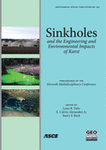Causes of House Subsidence in an Area Adjacent to Illinois' Sinkhole Plain
Publication: Sinkholes and the Engineering and Environmental Impacts of Karst
Abstract
In 2004, the Illinois State Geological Survey (ISGS) was contacted by two homeowners in southwestern Illinois about subsidence problems with their houses. Although bedrock in southwestern Illinois is predominantly made up of Mississippian-age limestone, and is the site of Illinois' sinkhole plain, the houses were located about 1.6 kilometers (km) from the nearest karst feature. In addition, bedrock beneath the houses was made up of Aux Vases Sandstone (not a karst-forming unit). However, the sandstone in this area is intercalated with and underlain by Ste. Genevieve Limestone, a major karst-forming unit in Illinois and other states, and the sandstone bedrock is bounded on two sides by covered karst limestone. We conducted an examination of the houses using aerial photographs, drill logs, and seismic and resistivity surveys across an apparent lineament between the two houses. The seismic survey revealed a 75 meter (m)-wide zone of disturbance in the bedrock surface that consisted of at least seven crevices bounding six slightly rotated blocks. Vertical disruption of the blocks was only on the order of a meter. Based on our observations of sinkhole formation in the sinkhole plain to the west, that bedrock crevices were at least 15 cm or more wide and were the main reason for the subsidence beneath the houses. The resistivity survey showed that the sediment overlying the trend between the two houses and probably the sediment beneath the two houses is saturated. The wetness of the material beneath the houses is probably the result of storm runoff infiltrating near the houses which would be conducive to piping and soil collapse into the bedrock crevices/conduits along the trend. Further, the resistivity survey showed areas of high resistivity (low conductivity) along the same trend that we interpreted as open cavities in the soil zone and within bedrock. These were probably the features into which sediment was collapsing suggesting that they are fairly substantial openings, possibly characterized as incipient sinkholes in the soil zone and a collapsed cave system in bedrock.
Get full access to this chapter
View all available purchase options and get full access to this chapter.
Information & Authors
Information
Published In
Copyright
© 2008 American Society of Civil Engineers.
History
Published online: Jun 20, 2012
Authors
Metrics & Citations
Metrics
Citations
Download citation
If you have the appropriate software installed, you can download article citation data to the citation manager of your choice. Simply select your manager software from the list below and click Download.
